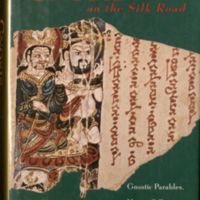Gnosis on the Silk Road: Gnostic Texts from Central Asia
Dublin Core
Title
Gnosis on the Silk Road: Gnostic Texts from Central Asia
Subject
Manichaeism -- Asia, Central
Asia, Central -- Religion
Asia, Central -- Religion
Description
In the late 1970s the first English translation of the Coptic texts discovered in Egypt in 1945, which came to be known as the Nag Hammadi Library, profoundly changed the world's understanding of Christianity. Now with the publication of Gnosis on the Silk Road - a never before published collection of extraordinary texts from the Gnostic tradition in Central Asia - renowned scholar and author Hans-Joachim Klimkeit has provided a unique Eastern companion text to that important work.
This first-ever English translation of the major Gnostic texts from Asia is a vital discovery that reveals a new expression of Christianity as it blended with the mystical religions of Turkey, Persia, Central Asia, and even China.
Klimkeit presents an astonishing collection of parables, hymns, narratives, and prayers that unveil a major Christian movement primarily founded by the prophet Mani, who merged Gnostic Christianity with the radical religious dualism of Persian religion and Zoroaster. As the movement spread along the Silk Road from Turkey to Asia, it adopted prominent features from Hinduism, Buddhism, and other Asian faiths.
The result was a Christian philosophy and practice that was much closer to the mystical, meditative religions of the East. Like the Western Gnosticism reflected in the Nag Hammadi Library, this Eastern Gnosticism was condemned as heresy by orthodox Christianity, and only today with the opening up of the former Soviet Union and the increased awareness of the importance of the Silk Road has the world been given a chance to learn from this radically different approach to Christianity.
This first-ever English translation of the major Gnostic texts from Asia is a vital discovery that reveals a new expression of Christianity as it blended with the mystical religions of Turkey, Persia, Central Asia, and even China.
Klimkeit presents an astonishing collection of parables, hymns, narratives, and prayers that unveil a major Christian movement primarily founded by the prophet Mani, who merged Gnostic Christianity with the radical religious dualism of Persian religion and Zoroaster. As the movement spread along the Silk Road from Turkey to Asia, it adopted prominent features from Hinduism, Buddhism, and other Asian faiths.
The result was a Christian philosophy and practice that was much closer to the mystical, meditative religions of the East. Like the Western Gnosticism reflected in the Nag Hammadi Library, this Eastern Gnosticism was condemned as heresy by orthodox Christianity, and only today with the opening up of the former Soviet Union and the increased awareness of the importance of the Silk Road has the world been given a chance to learn from this radically different approach to Christianity.
Source
Translations from Iranian and Turkish texts.
Publisher
San Francisco, Calif. : HarperSanFrancisco
Contributor
translated & presented by Hans-Joachim Klimkeit
Text Item Type Metadata
Original Format
Book
Citation
“Gnosis on the Silk Road: Gnostic Texts from Central Asia,” Humanities Hub, accessed December 28, 2025, https://humanitieshub.sdsu.edu/omeka/items/show/465.


